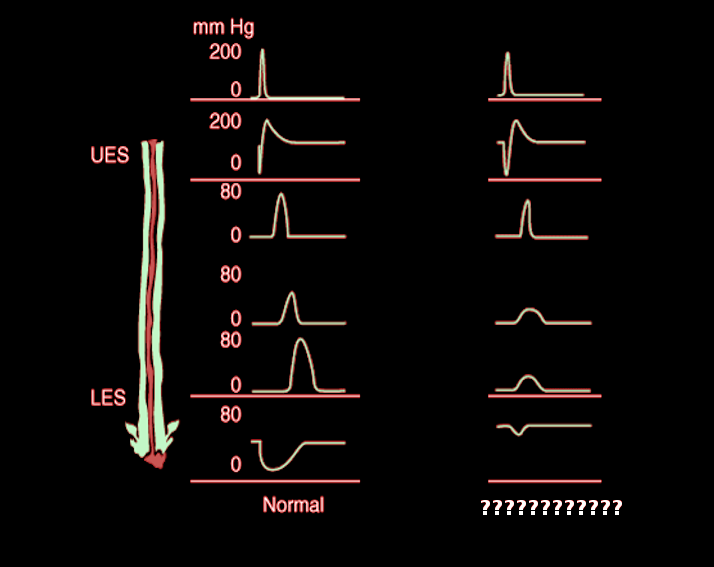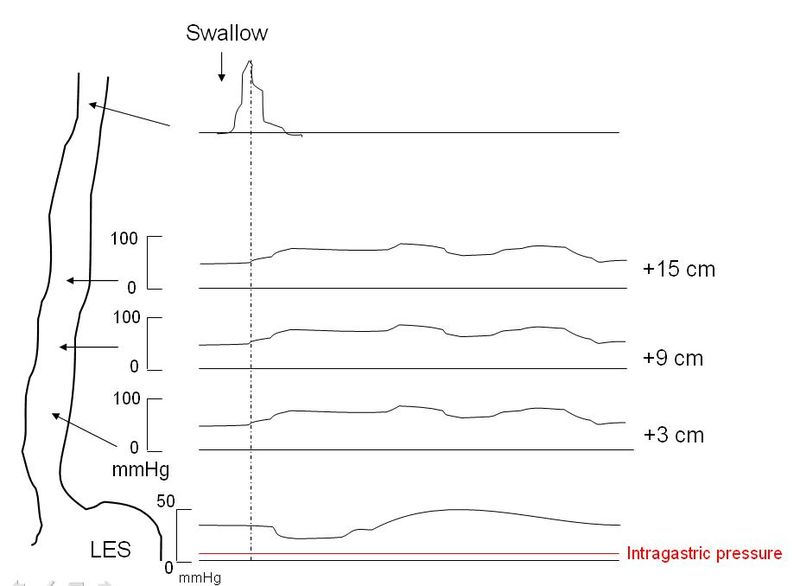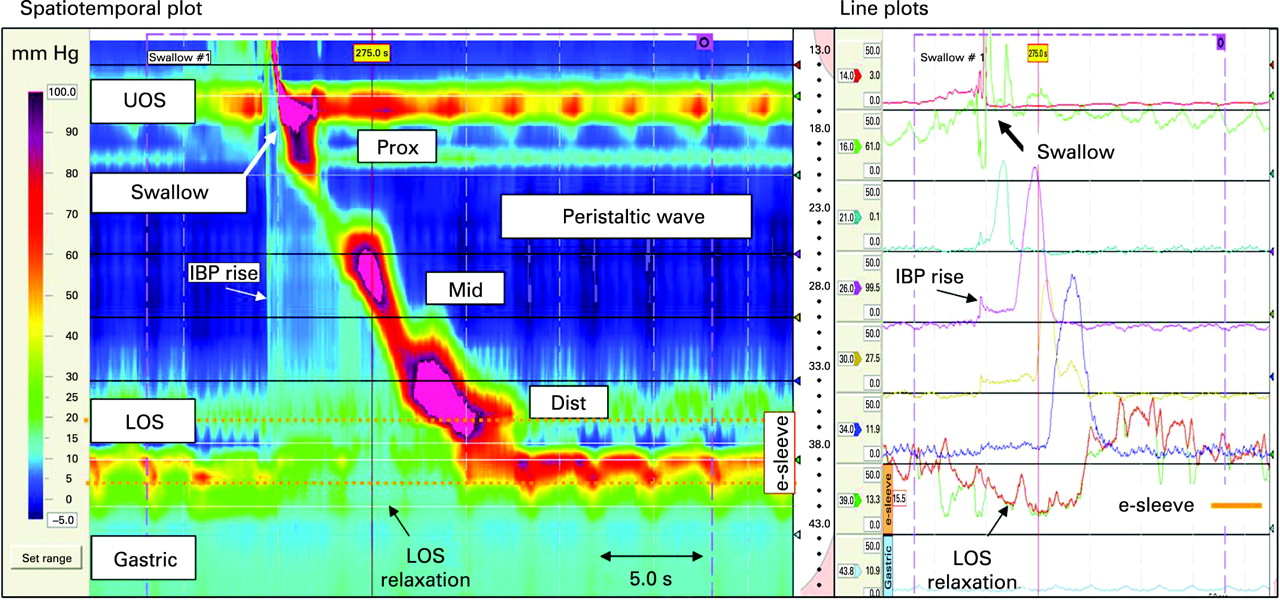[1]
Castell DO. Emerging Technologies for Esophageal Manometry and pH Monitoring. Gastroenterology & hepatology. 2008 Jun:4(6):404-6
[PubMed PMID: 21904516]
[2]
Yadlapati R. High-resolution esophageal manometry: interpretation in clinical practice. Current opinion in gastroenterology. 2017 Jul:33(4):301-309. doi: 10.1097/MOG.0000000000000369. Epub
[PubMed PMID: 28426462]
Level 3 (low-level) evidence
[3]
Kahrilas PJ, Bredenoord AJ, Fox M, Gyawali CP, Roman S, Smout AJ, Pandolfino JE, International High Resolution Manometry Working Group. The Chicago Classification of esophageal motility disorders, v3.0. Neurogastroenterology and motility. 2015 Feb:27(2):160-74. doi: 10.1111/nmo.12477. Epub 2014 Dec 3
[PubMed PMID: 25469569]
[4]
Trudgill NJ, Sifrim D, Sweis R, Fullard M, Basu K, McCord M, Booth M, Hayman J, Boeckxstaens G, Johnston BT, Ager N, De Caestecker J. British Society of Gastroenterology guidelines for oesophageal manometry and oesophageal reflux monitoring. Gut. 2019 Oct:68(10):1731-1750. doi: 10.1136/gutjnl-2018-318115. Epub 2019 Jul 31
[PubMed PMID: 31366456]
[5]
Elvevi A, Mauro A, Pugliese D, Bravi I, Tenca A, Consonni D, Conte D, Penagini R. Usefulness of low- and high-volume multiple rapid swallowing during high-resolution manometry. Digestive and liver disease : official journal of the Italian Society of Gastroenterology and the Italian Association for the Study of the Liver. 2015 Feb:47(2):103-7. doi: 10.1016/j.dld.2014.10.007. Epub 2014 Nov 12
[PubMed PMID: 25458779]
[6]
Ang D, Misselwitz B, Hollenstein M, Knowles K, Wright J, Tucker E, Sweis R, Fox M. Diagnostic yield of high-resolution manometry with a solid test meal for clinically relevant, symptomatic oesophageal motility disorders: serial diagnostic study. The lancet. Gastroenterology & hepatology. 2017 Sep:2(9):654-661. doi: 10.1016/S2468-1253(17)30148-6. Epub 2017 Jul 3
[PubMed PMID: 28684262]
[7]
Ang D, Hollenstein M, Misselwitz B, Knowles K, Wright J, Tucker E, Sweis R, Fox M. Rapid Drink Challenge in high-resolution manometry: an adjunctive test for detection of esophageal motility disorders. Neurogastroenterology and motility. 2017 Jan:29(1):. doi: 10.1111/nmo.12902. Epub 2016 Jul 15
[PubMed PMID: 27420913]
[8]
. American Gastroenterological Association medical position statement on management of oropharyngeal dysphagia. Gastroenterology. 1999 Feb:116(2):452-4
[PubMed PMID: 9922327]
[9]
Rohof WOA, Bredenoord AJ. Chicago Classification of Esophageal Motility Disorders: Lessons Learned. Current gastroenterology reports. 2017 Aug:19(8):37. doi: 10.1007/s11894-017-0576-7. Epub
[PubMed PMID: 28730503]
[10]
Bogte A, Bredenoord AJ, Oors J, Siersema PD, Smout AJ. Normal values for esophageal high-resolution manometry. Neurogastroenterology and motility. 2013 Sep:25(9):762-e579. doi: 10.1111/nmo.12167. Epub 2013 Jun 12
[PubMed PMID: 23803156]
[11]
Bredenoord AJ, Fox M, Kahrilas PJ, Pandolfino JE, Schwizer W, Smout AJ, International High Resolution Manometry Working Group. Chicago classification criteria of esophageal motility disorders defined in high resolution esophageal pressure topography. Neurogastroenterology and motility. 2012 Mar:24 Suppl 1(Suppl 1):57-65. doi: 10.1111/j.1365-2982.2011.01834.x. Epub
[PubMed PMID: 22248109]
[12]
Lee JY, Kim N, Kim SE, Choi YJ, Kang KK, Oh DH, Kim HJ, Park KJ, Seo AY, Yoon H, Shin CM, Park YS, Hwang JH, Kim JW, Jeong SH, Lee DH. Clinical characteristics and treatment outcomes of 3 subtypes of achalasia according to the chicago classification in a tertiary institute in Korea. Journal of neurogastroenterology and motility. 2013 Oct:19(4):485-94. doi: 10.5056/jnm.2013.19.4.485. Epub 2013 Oct 7
[PubMed PMID: 24199009]
[13]
Ihara E, Muta K, Fukaura K, Nakamura K. Diagnosis and Treatment Strategy of Achalasia Subtypes and Esophagogastric Junction Outflow Obstruction Based on High-Resolution Manometry. Digestion. 2017:95(1):29-35. doi: 10.1159/000452354. Epub 2017 Jan 5
[PubMed PMID: 28052278]
[14]
Clément M, Zhu WJ, Neshkova E, Bouin M. Jackhammer Esophagus: From Manometric Diagnosis to Clinical Presentation. Canadian journal of gastroenterology & hepatology. 2019:2019():5036160. doi: 10.1155/2019/5036160. Epub 2019 Mar 3
[PubMed PMID: 30941328]
[15]
Ghosh SK, Pandolfino JE, Zhang Q, Jarosz A, Shah N, Kahrilas PJ. Quantifying esophageal peristalsis with high-resolution manometry: a study of 75 asymptomatic volunteers. American journal of physiology. Gastrointestinal and liver physiology. 2006 May:290(5):G988-97
[PubMed PMID: 16410365]
[16]
Laique S, Singh T, Dornblaser D, Gadre A, Rangan V, Fass R, Kirby D, Chatterjee S, Gabbard S. Clinical Characteristics and Associated Systemic Diseases in Patients With Esophageal "Absent Contractility"-A Clinical Algorithm. Journal of clinical gastroenterology. 2019 Mar:53(3):184-190. doi: 10.1097/MCG.0000000000000989. Epub
[PubMed PMID: 29356781]
[17]
Ravi K, Friesen L, Issaka R, Kahrilas PJ, Pandolfino JE. Long-term Outcomes of Patients With Normal or Minor Motor Function Abnormalities Detected by High-resolution Esophageal Manometry. Clinical gastroenterology and hepatology : the official clinical practice journal of the American Gastroenterological Association. 2015 Aug:13(8):1416-23. doi: 10.1016/j.cgh.2015.02.046. Epub 2015 Mar 11
[PubMed PMID: 25771245]
[18]
Roman S, Kahrilas PJ, Kia L, Luger D, Soper N, Pandolfino JE. Effects of large hiatal hernias on esophageal peristalsis. Archives of surgery (Chicago, Ill. : 1960). 2012 Apr:147(4):352-7. doi: 10.1001/archsurg.2012.17. Epub
[PubMed PMID: 22508779]
[19]
Meister V, Schulz H, Greving I, Imhoff M, Walter LD, May B. [Perforation of the esophagus after esophageal manometry]. Deutsche medizinische Wochenschrift (1946). 1997 Nov 14:122(46):1410-4
[PubMed PMID: 9417381]
[20]
Kahrilas PJ, Pandolfino JE. Treatments for achalasia in 2017: how to choose among them. Current opinion in gastroenterology. 2017 Jul:33(4):270-276. doi: 10.1097/MOG.0000000000000365. Epub
[PubMed PMID: 28426463]
Level 3 (low-level) evidence
[21]
Pérez-Fernández MT, Santander C, Marinero A, Burgos-Santamaría D, Chavarría-Herbozo C. Characterization and follow-up of esophagogastric junction outflow obstruction detected by high resolution manometry. Neurogastroenterology and motility. 2016 Jan:28(1):116-26. doi: 10.1111/nmo.12708. Epub 2015 Oct 30
[PubMed PMID: 26517978]
[22]
Wang L, Li YM, Li L. Meta-analysis of randomized and controlled treatment trials for achalasia. Digestive diseases and sciences. 2009 Nov:54(11):2303-11. doi: 10.1007/s10620-008-0637-8. Epub 2008 Dec 24
[PubMed PMID: 19107596]
Level 1 (high-level) evidence
[23]
Boeckxstaens GE, Annese V, des Varannes SB, Chaussade S, Costantini M, Cuttitta A, Elizalde JI, Fumagalli U, Gaudric M, Rohof WO, Smout AJ, Tack J, Zwinderman AH, Zaninotto G, Busch OR, European Achalasia Trial Investigators. Pneumatic dilation versus laparoscopic Heller's myotomy for idiopathic achalasia. The New England journal of medicine. 2011 May 12:364(19):1807-16. doi: 10.1056/NEJMoa1010502. Epub
[PubMed PMID: 21561346]
[24]
Moonen A, Annese V, Belmans A, Bredenoord AJ, Bruley des Varannes S, Costantini M, Dousset B, Elizalde JI, Fumagalli U, Gaudric M, Merla A, Smout AJ, Tack J, Zaninotto G, Busch OR, Boeckxstaens GE. Long-term results of the European achalasia trial: a multicentre randomised controlled trial comparing pneumatic dilation versus laparoscopic Heller myotomy. Gut. 2016 May:65(5):732-9. doi: 10.1136/gutjnl-2015-310602. Epub 2015 Nov 27
[PubMed PMID: 26614104]
Level 1 (high-level) evidence
[25]
Familiari P, Gigante G, Marchese M, Boskoski I, Tringali A, Perri V, Costamagna G. Peroral Endoscopic Myotomy for Esophageal Achalasia: Outcomes of the First 100 Patients With Short-term Follow-up. Annals of surgery. 2016 Jan:263(1):82-7. doi: 10.1097/SLA.0000000000000992. Epub
[PubMed PMID: 25361224]
[26]
Kumbhari V, Tieu AH, Onimaru M, El Zein MH, Teitelbaum EN, Ujiki MB, Gitelis ME, Modayil RJ, Hungness ES, Stavropoulos SN, Shiwaku H, Kunda R, Chiu P, Saxena P, Messallam AA, Inoue H, Khashab MA. Peroral endoscopic myotomy (POEM) vs laparoscopic Heller myotomy (LHM) for the treatment of Type III achalasia in 75 patients: a multicenter comparative study. Endoscopy international open. 2015 Jun:3(3):E195-201. doi: 10.1055/s-0034-1391668. Epub 2015 Apr 13
[PubMed PMID: 26171430]
Level 2 (mid-level) evidence



